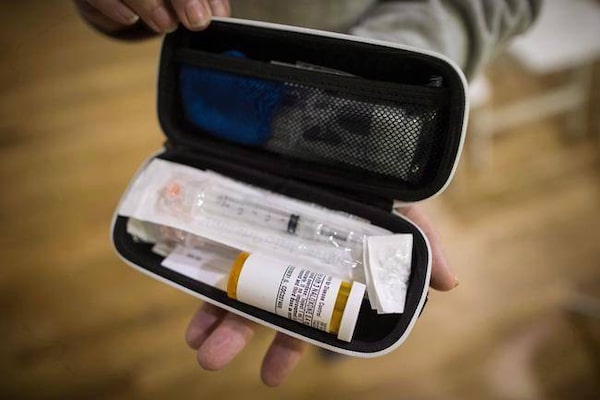
People who use drugs alone indoors make up the demographic with the highest rate of overdose deaths in the province; according to the B.C. Coroners Service, 88 per cent of illicit drug overdose deaths so far this year have occurred in places such as private residences, SROs and shelters.The Canadian Press
In her single-room occupancy hotel on Vancouver’s Downtown Eastside, Samantha Pranteau said the calls for naloxone seemed constant.
As fentanyl poisoned the city’s heroin trade and overdoses mounted, she said she would hear someone shouting for the life-saving drug “daily, weekly.”
“There were times where there were no kits in the building at all,” Ms. Pranteau said, “and folks had to run out into the street or other places to find a kit and [the overdose victims] were left unattended while people were trying to find kits.”
Last summer, Ms. Pranteau participated in a pilot project led by the SRO Collaborative, a Downtown Eastside tenant advocacy group, and evaluated by B.C. Centre on Substance Use, aimed at addressing overdoses in single-room occupancy hotels, otherwise known as SROs.
People who use drugs alone indoors make up the demographic with the highest rate of overdose deaths in the province; according to the B.C. Coroners Service, 88 per cent of illicit drug overdose deaths so far this year have occurred in places such as private residences, SROs and shelters. This prompted health officials to explore ways to reach the hard-to-reach. The goal was to provide SRO tenants with the skills and means to save the lives of their fellow tenants.
At a time when many jurisdictions are still weighing the merits of supervised drug-consumption sites, the project is an example of B.C. health officials tailoring an overdose response for those in the population considered to be at greatest risk.
A report on the findings of the Tenant Overdose Response Organizers (TORO) program was published on Thursday in the Journal of Urban Health.
The TORO program saw 20 participants from 10 privately owned SROs work with a nurse from Vancouver Coastal Health to provide on-site naloxone training to other residents. The tenant organizers also held biweekly follow-up and ad hoc sessions for several months and served as the main overdose-response contacts in their buildings.
The tenants learned how to administer the overdose-reversing drug and stocked a supply of it within their buildings. Tenants who always kept a kit on hand made this known with stickers on their doors. Some participants later told researchers they felt a sense of empowerment having learned life-saving skills.
Ms. Pranteau, a tenant organizer, said buildings also identified “floor captains” who were keen to be more involved in looking after others. “They then mentored other people in the buildings,” she said. “Some people are more comfortable just handing out naloxone, some people are more comfortable training others.”
Senior researcher Ryan McNeil said the program also helped build a sense of community among tenants.
“We know that people in private SROs are often highly, highly socially isolated,” Mr. McNeil said. “In many cases, given the high rate of evictions and housing vulnerability, people often move in and out of certain places fairly often. We found that [the program] really fostered the sense of community in the buildings, to the extent that the intervention was possible.”
But the program was not without its challenges. While some SRO managers were supportive, participating in the training themselves, others viewed the naloxone workshops as a tacit acceptance of drug use and sought to disrupt them.
“We know through all the recent attention around places like the Regent and the Balmoral that some SROs in Vancouver are in horrible conditions, and environments that are not necessarily amenable to the extension of public-health interventions – or really anything supportive of tenants,” Mr. McNeil said. “There was one building, for example, that we were literally chased out of.”
Editor’s note: A previous version of this story incorrectly spelled Samantha Pranteau's name.
 Andrea Woo
Andrea Woo